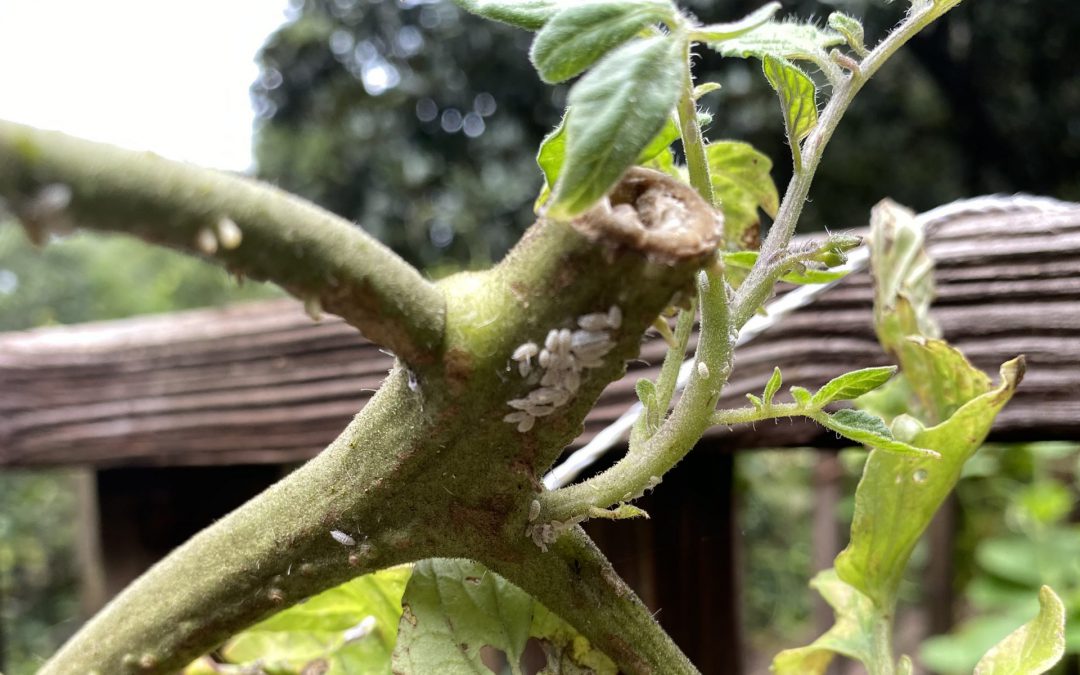
by Matt Lollar | Aug 24, 2020
A common question for gardeners at the end of the season is if one should till the soil or use no till practices. Opinions vary regarding this question, even among Extension Agents. However old crops harbor insects, both good and bad. This phenomenon was noticed on some recently cut back tomato plants. The intention was to cut the leftover spring garden tomatoes back to encourage fall production. Instead, a host plant for mealybugs was provided.
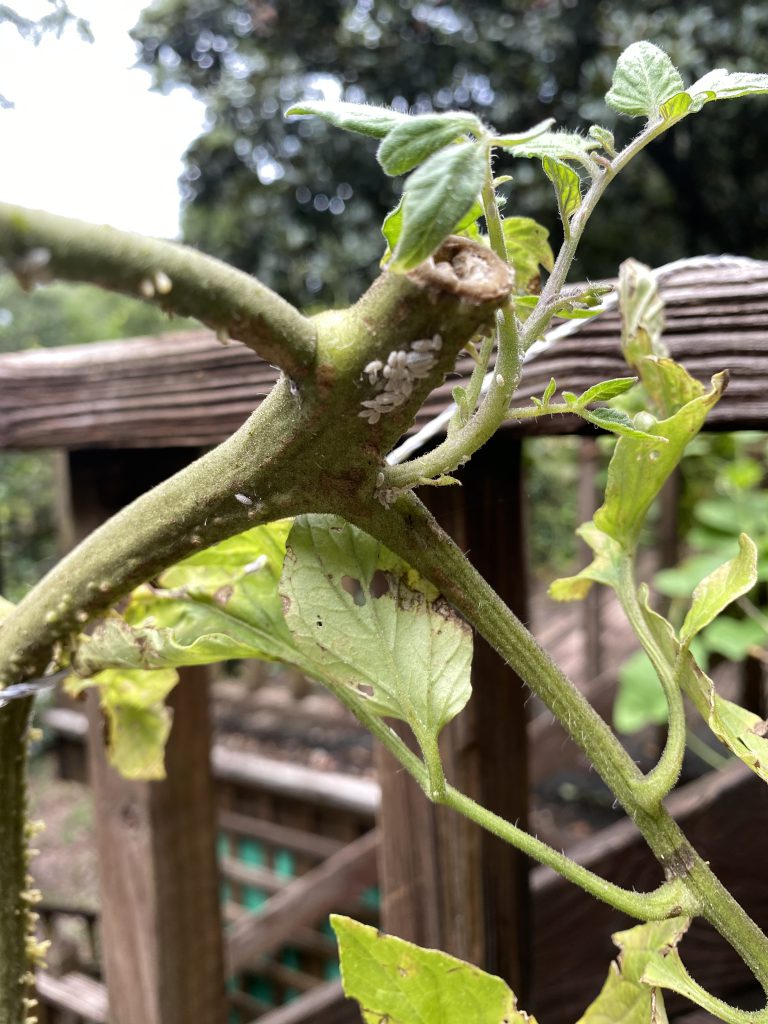
Mealybugs on a tomato plant. Photo Credit: Matt Lollar, University of Florida/IFAS Extension – Santa Rosa County
Mealybugs are soft-bodied insects that possess a covering of flocculent, white, waxy filaments. They are about 1/8 inch in length and usually pinkish or yellowish in color. Mealybugs have piercing-sucking mouthparts which they use to siphon fluids from the leaves, stems, and sometimes roots of many ornamental and vegetable plants. Mealybug damage produces discolored, wilted, and deformed leaves.
One very common example of an insect pest likely to claim residence in your garden’s crop residue, are squash bugs. They like to overwinter on squash, cucumber, and other cucurbit crop residue. If you choose to not till your garden and leave a portion of last seasons crop in your garden, then you should consider applying an insecticide to your spent crop at the end of the season. A product containing a pyrethrin or pyrethroid as an active ingredient would be a good broad spectrum insecticide to control any pest that may reside on plant residue. More information on pyrethrins and pyrehtroids can be found at the EPA webpage: Pyrethrins and Pyrethroids. If you choose to apply an insecticide, it is important that you follow the information on the label regarding pollinator protection. Another option is to plant a trap crop on the edge of your garden to help attract pest insects away from your desired crops. More information on trap crops can be found in the EDIS Publication: Intercropping, Pest Management and Crop Diversity.
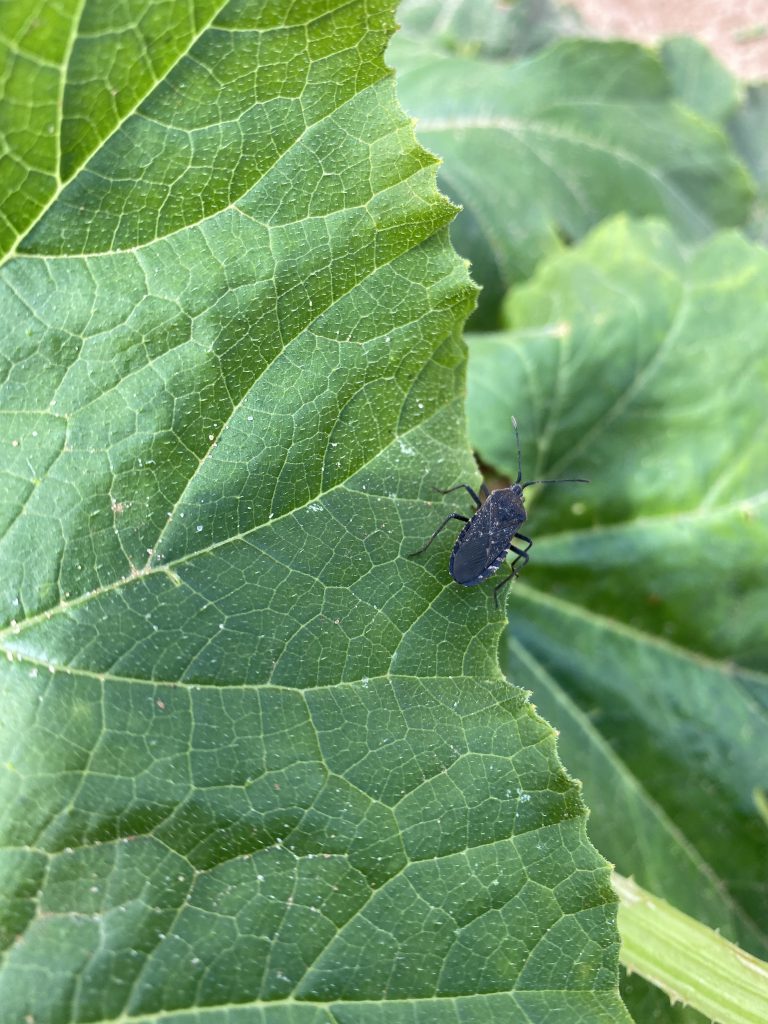
An adult squash bug on a zucchini leaf. Photo Credit: Matt Lollar, University of Florida/IFAS Extension – Santa Rosa County
So the answer to the till or no till question is…it depends. It is really up to the gardener. Yes, the residue from crops will add nutrients and organic matter to your soil, but it could also increase pest pressure in your garden. If you don’t plan to remove crop residue and don’t plan to till, then keep an eye out for what could be hiding in your garden.

by Larry Williams | Aug 14, 2020
Oleander caterpillars, which are active on some oleanders during summer, can provide a number of gardening lessons.
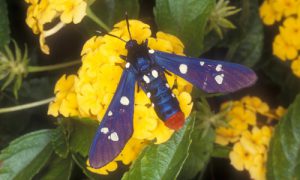
Oleander caterpillar moth on lantana flower. Photo credit: James Castner, UF
The adult moth is striking in appearance. The bluish to purplish moth has white dots on its black wings. The moths resemble wasps as they fly in and around oleander shrubs.
It’s the orange caterpillars with black spots and black hairs that cause problems for some gardeners.
Caterpillars are the larval stage of butterflies and moths. In order to enjoy watching butterflies and moths feeding on the nectar of flowers, some of the caterpillars must survive to become adult butterflies and moths. This is lesson number one.
Oleander caterpillars usually only feed on oleander plants. Oleanders are native to areas of Europe and Asia. This is lesson number two.
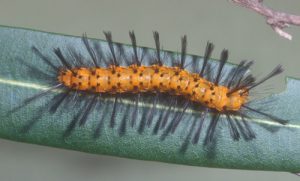
Oleander caterpillar, Photo credit: Paul Choate, UF
Oleander caterpillars benefit by us planting their food source in Florida.
This relationship between pest and plant is referred to as the key plant, key pest concept. Some other examples include St. Augustinegrass and chinch bugs, gardenias and whiteflies, crape myrtles and crape myrtle aphids, azaleas and azalea caterpillars, camellias and tea scale, roses and black spot, pecans and pecan scab, squash and squash vine borers.
Understanding this concept can be helpful in designing a “low maintenance” landscape.
When you plant roses, you plant everything that goes with roses, including the time and money required to maintain them. This applies to St. Augustinegrass, pecan trees, squash and oleanders. This is lesson number three.
Oleander caterpillars can temporarily damage the appearance of oleanders. But they cause no long-term damage for the plant. This is lesson number four. The damage is aesthetic. Oleander caterpillars can consume great numbers of leaves. However, if the plant is otherwise healthy, new leaves will be produced and the plant will continue to grow. The damage is temporary; there will be no evidence the plant ever had a problem.
To spray or not to spray for oleander caterpillars has to do with a person’s tolerance level.
If you can’t tolerate having oleander caterpillars around and the temporary aesthetic damage they cause, consider the use of Bacillus thuringiensis. It is sold under a number of brand names and many times is referred to as Bt. This bacterium only controls caterpillars so it is friendlier for the beneficial insects. When using any pesticide, always follow the label directions and precautions.
Here are links to UF/IFAS Extension publications with more info.
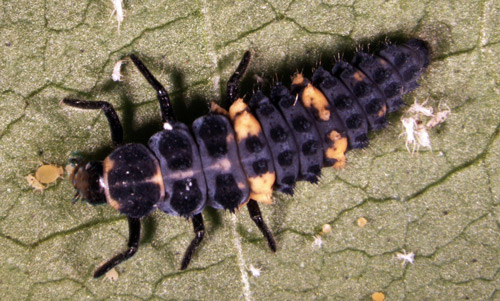
by Daniel J. Leonard | Aug 6, 2020
I know this is going to come as a shock to some readers, but not all bugs are bad. In fact, while there are over 1 million species of insects worldwide, less than 1% are problem pests! This problem 1%, composed of common garden pests, including aphids, stinkbugs, nuisance caterpillars, and scales, get all the attention and for good reason; they can be extremely destructive to home and commercial crops. However, the good guys, beneficial predatory insects, are out there too, providing valuable pest control day and night and should be considered in part of a quality garden pest management strategy.
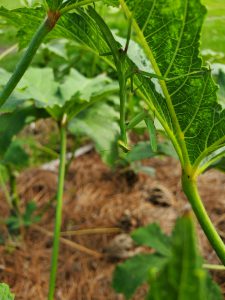 Beneficials come in many shapes and sizes. Some are commonly known predators, such as spiders, Lady Beetles and Praying Mantids, while others are lesser known pest nemeses, like Paper Wasps, Pirate Bugs, and Lacewings. Regardless, gardeners should do their homework and be able to identify beneficials when they see them and allow them to do their jobs. The presence, or not, of a handful of Lady Beetles or Lacewings on the attack can be the difference between needing to treat with insecticides for an aphid outbreak or just letting nature take its course. Studies have shown that just one individual Lady Beetle in the larval stage can consume as many as 500 aphids; adult Lady Beetles are even hungrier aphid eaters! Paper Wasps, you know the ones who make the large “papery” nests around eaves of house and other structures, play an important beneficial role, frequently preying on caterpillars. If their nests aren’t near highly trafficked areas around your home and you don’t have family members allergic to wasp stings, your garden will thank you for leaving a few paper wasp colonies as caterpillar insurance!
Beneficials come in many shapes and sizes. Some are commonly known predators, such as spiders, Lady Beetles and Praying Mantids, while others are lesser known pest nemeses, like Paper Wasps, Pirate Bugs, and Lacewings. Regardless, gardeners should do their homework and be able to identify beneficials when they see them and allow them to do their jobs. The presence, or not, of a handful of Lady Beetles or Lacewings on the attack can be the difference between needing to treat with insecticides for an aphid outbreak or just letting nature take its course. Studies have shown that just one individual Lady Beetle in the larval stage can consume as many as 500 aphids; adult Lady Beetles are even hungrier aphid eaters! Paper Wasps, you know the ones who make the large “papery” nests around eaves of house and other structures, play an important beneficial role, frequently preying on caterpillars. If their nests aren’t near highly trafficked areas around your home and you don’t have family members allergic to wasp stings, your garden will thank you for leaving a few paper wasp colonies as caterpillar insurance!
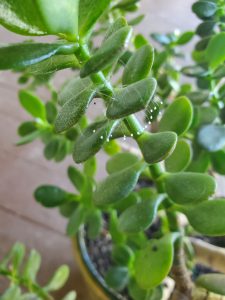
Lacewing eggs on a Jade plant in close proximity to the author’s vegetable garden.
In many instances, beneficial insects can keep pest insect infestations at bay, allowing gardeners to spot treat outbreaks when they get out of hand or even prevent the problem from needing chemical intervention altogether.
As helpful as they are, beneficial insects in the garden won’t totally negate the need for chemical treatment entirely. From time to time, garden pest populations outpace the beneficials’ abilities to kill them and intervention from humans is needed. In these times, it is advisable to use a couple of best practices to limit exposure to beneficial insects. First, try to use selective insecticides that only target specific pests and are nontoxic to other bugs, like the product Bt for caterpillar pests (sold under many brands like Dipel, Garden Safe Bt Worm and Caterpillar Killer, Thuricide, etc). However, if a nonselective, general insecticide, like the Pyrethroids (many common homeowner insecticide brands) and carbamates (Sevin and others), is needed, timing these broad spectrum sprays for early in the morning and late in the evening when many beneficials are not very active can help reduce friendly fire casualties. Care should also be taken to only spot treat infested plants and not the entire garden, this helps reduce beneficial exposure to these broadly toxic pesticides.
Every gardener should have a plan for pest control and beneficials can play an important role in this overall strategy. Gardeners can help ensure that nature pulls its weight in controlling problem pests by taking a little time to scout for beneficial insect populations, keeping a close eye on developing pest outbreaks, using selective insecticides when you can, and only spraying broad spectrum products as spot treatments when necessary and timing those applications for very early or late in the day. If you have a question about whether or not a garden insect is a good guy or a pest or want more information on garden pest control strategies, contact your local UF/IFAS County Extension Office! Happy Gardening!
The following resources were used in the development of this article:
https://gardeningsolutions.ifas.ufl.edu/care/florida-friendly-landscapes/beneficial-insects.html
https://sfyl.ifas.ufl.edu/sarasota/gardening-and-landscaping/horticulture-commercial/integrated-pest-management/beneficial-insects/
http://www.missouribotanicalgarden.org/gardens-gardening/your-garden/help-for-the-home-gardener/advice-tips-resources/pests-and-problems/other/beneficial-insects.aspx
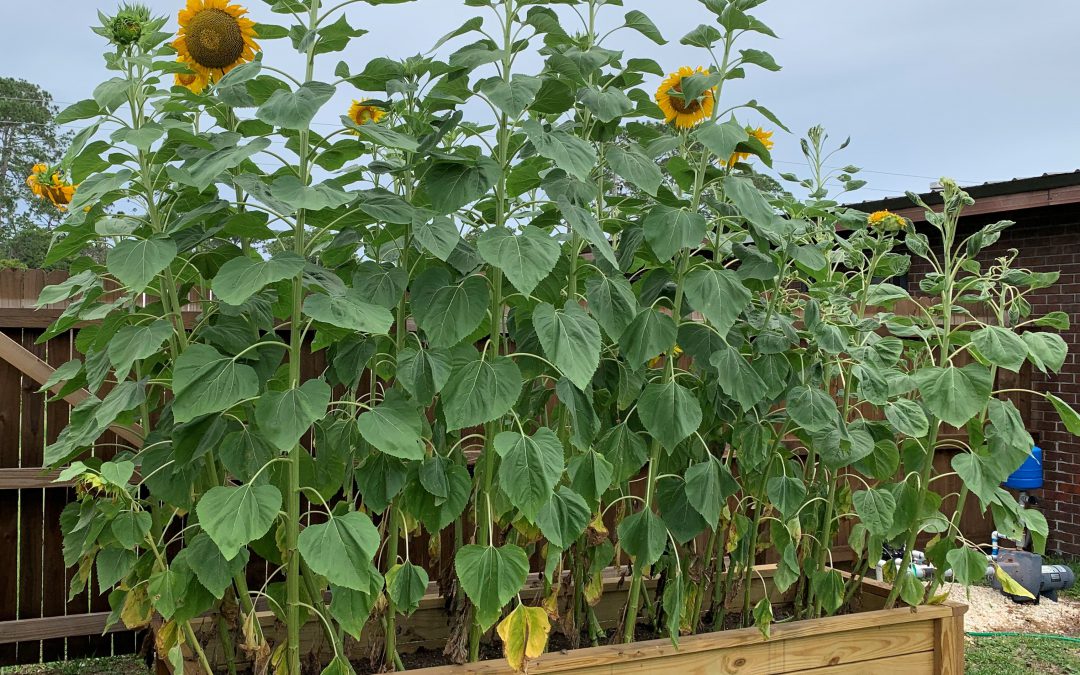
by Ray Bodrey | Jul 1, 2020
Sunflowers, Helianthus spp., are a great choice for gardeners who are looking for some cheerful color in their landscape. Here in Florida, we have the main ingredient for success, lots of sunshine!
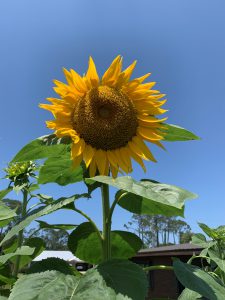
‘Skyscraper’ Sunflower bloom. Photo courtesy of Ray Bodrey.
Sunflowers are short-lived annuals. The average time between planting and bloom is roughly 65 days. You can typically plant sunflowers in Florida beginning in late winter until early fall. Only the coldest months cause problems, and for most years that’s only November – January. Sunflowers can be planted almost anywhere there is full sun. The major selling point with sunflowers is, of course, the impressive blooms (figure 1). These yellow to sometimes orange or red-petaled flowers develop a central seed disc, with most variety’s flowers having approximately an 8” diameter.
When planting, you may choose to plant in narrow rows with close seed spacing in order to cull weaker plants later. A final row and seed spacing of 2’-3’ is recommended for full height and development of most varieties. However, you may also choose to plant in a bed, using a close pattern as seen in the photo below. In any event, sunflowers are easy to propagate by seed and are very low maintenance. Occasionally, powdery mildew and spittle bugs can be a nuisance. A general garden fungicide and insecticide will help if problems occur.
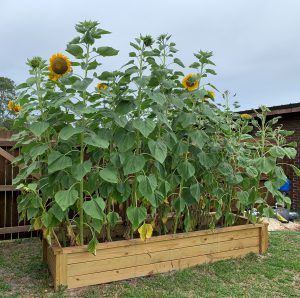
‘Skyscraper’ sunflowers planted on close spacing. Photo courtesy Ray Bodrey.
Sunflowers are available in many varieties, consisting of different color blooms and plant sizes. These sizes range from dwarf (1’-3’) to tall (10’-15’) varieties. You may wish to stake taller varieties at some point, as plants will tend to lean with no wind break in place. Here’s a few garden variety common names to look for: ‘Sunbright’, ‘Sonja’, ‘Sunrich Lemon’, ‘Sunrich Orange’ and ‘Autumn beauty’. Seed companies also have mixes available in packets. For tall plants, ‘Mammoth’ or ‘Skyscraper’ varieties will do the trick.
If you are fond of the sunflower bloom and looking for a groundcover, there are a couple of native perennials that fit this category. Beach sunflower, Helianthus debilis or swamp sunflower, Helianthus angustifolius, are groundcovers/ornamentals for landscapes and thrive in dry, hot climates and in a range of soil types. They also are great pollinator attractors.
For more information on growing sunflowers, contact your local county extension office.
Supporting information for this article and links to other publications on sunflowers can be found at the UF/IFAS Gardening Solutions website: https://gardeningsolutions.ifas.ufl.edu/plants/ornamentals/sunflowers.html
UF/IFAS Extension is an Equal Opportunity Institution.
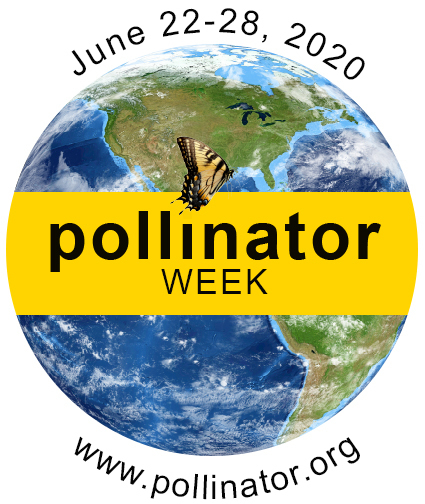
by Mary Salinas | Jun 23, 2020
For the 13th year we celebrate National Pollinator Week June 22-28 to bring awareness to the importance of our pollinators and the challenges they face. This is an opportunity to learn about ways to protect pollinators in our own landscapes. Every one of us can make a difference.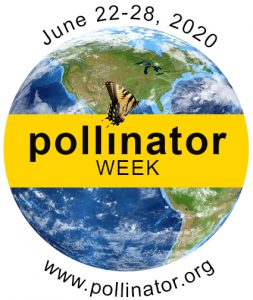
When we hear the word ‘pollinator’ most of us immediately think of honeybees. They are very important but there are so many other creatures that are important pollinators:
- Native bees – Florida alone has over 300 species of bees
- Hummingbirds – their long beaks can reach into long, tubular blooms
- Bats – they pollinate over 500 plants including banana, mango, and agave (used to make tequila)
- Beetles – considered to be a messy and minor pollinator; they pollinate the native paw paw
- Butterflies – a minor pollinator as most have long legs that keep them perched above the pollen
- Flies – pollinators of a variety of native plants
According to the USDA, 75% of flowering plants and about 35% of food crops around the globe rely on these animals for pollination. Without pollination, these plants would not reproduce or provide us food.
So, what can the average person do to make a difference?
- Plant what bees and butterflies love!
- Avoid using any insecticide unless it is absolutely necessary. Predators like assassin bugs, dragonflies and birds help to keep pests in check. Our songbirds rely on protein-rich insects (especially caterpillars) to feed their growing babies.
- Don’t treat areas where pollinators are visiting the flowers, whether in the lawn or the landscape beds.
- If you need to apply an insecticide to the lawn, mow first to remove the blooms from any weeds. Always follow the label instructions carefully.
- Avoid using a systemic insecticide on plants that bloom and attract pollinators. The insecticide can remain in plants for a long time.
Happy gardening during National Pollinator Week!
For more information:
Pollinator Partnership: Pollinator Week Activities
US Fish & Wildlife Pollinator Site
Native Insect Pollinators of the Southeastern United States brochure
Purdue University: Protecting Pollinators in Home Lawns and Landscapes
Minimizing Honey Bee Exposure to Pesticides
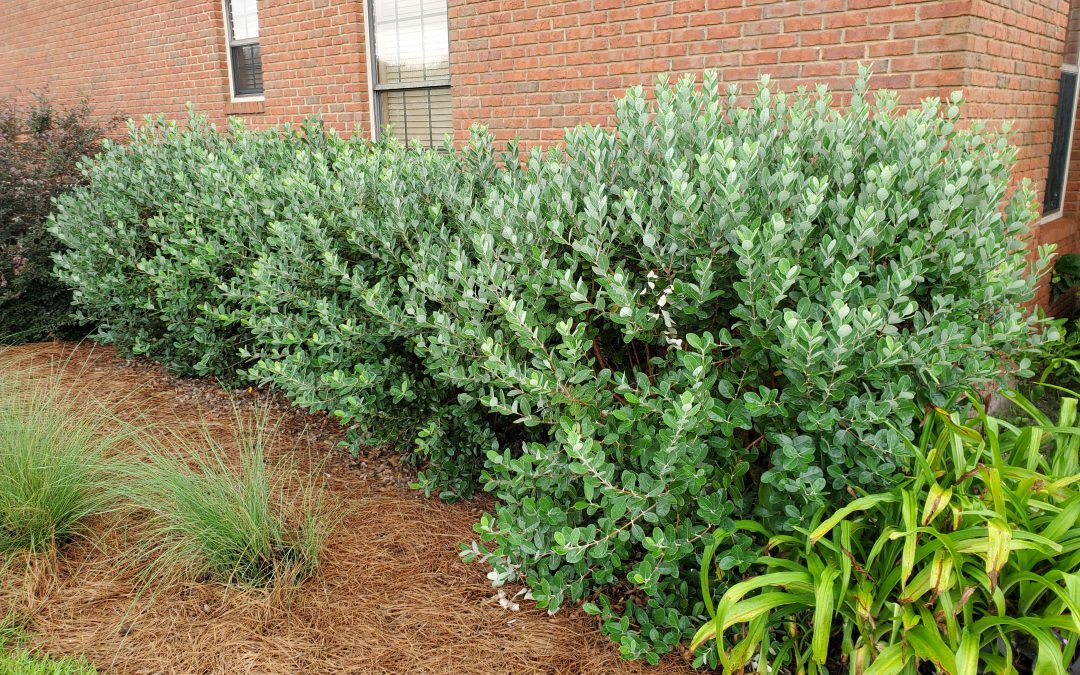
by Daniel J. Leonard | Jun 2, 2020
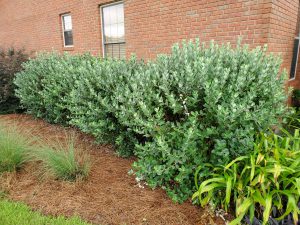
Pineapple Guava (Acca sellowiana) hedge. Photo courtesy of the author.
One of the most common questions I’ve gotten across the Panhandle over the last several years is “What can I plant to screen my house and property?” I surmise this has a lot to do with Hurricane Michael wiping properties clean and an explosion of new construction, but whatever the reason, people want privacy, they want it quickly, and they often want something a little more natural looking and aesthetically pleasing than a fence. Like everything else, the answer to the question is nuanced depending on the site situation. However, if the situation is right, I almost always recommend that clientele at least consider a woefully underutilized plant in the Panhandle, Pineapple Guava (Acca sellowiana).
Named a Florida Garden Select Plant by the Florida Nursery Growers and Landscape Association (FNGLA) in 2009, Pineapple Guava is a standout screening and specimen plant, passing all the usual tests homeowners demand from shrubs. Growing 15’x15’ or so if never pruned or sheared, these quick-growing evergreen shrubs sport pretty, leathery green leaves with gray to white undersides. This leaf underside coloring causes the plants to emit a striking silvery blue hue from a distance, a very unusual feature in the screening shrub world.
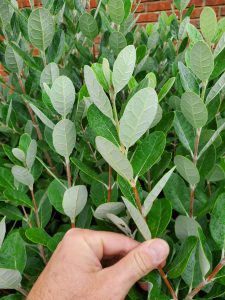
Pineapple Guava (Acca sellowiana) silvery blue leaf undersides. Photo courtesy of the author.
Look past the leaves and you’ll notice that Pineapple Guava also possesses attractive brownish, orange bark when young that fades to a pretty, peely gray with age. To complete the aesthetic trifecta, in late spring/early summer (generally May in the Panhandle), the plants, if not heavily sheared, develop gorgeous edible, pollinator-friendly flowers. These flowers, comprised of white petals with bright red to burgundy stamens in the center, then develop over the summer into tasty fruit that may be harvested in the fall.
In addition to being a superbly attractive species, Pineapple Guava is extremely easy to grow. They like full, all-day, blazing sunshine but will tolerate some shading if they receive at least six hours of direct sun. Well-drained soil is also a must. Pineapple Guava, like many of us, is not a fan of wet feet! Site them where excessive water from rain will drain relatively quickly. Adding to its merits, the species is not plagued by any serious pests or diseases and is also drought-tolerant, needing no supplemental irrigation once plants are established. A once a year application of a general-purpose fertilizer, if indicated by a soil test, may be useful in getting plants going in their first couple of years following planting, but is rarely necessary in subsequent years. To maintain Pineapple Guava as a formal hedge or screen, a simple shear or two each growing season is normally enough. The species also makes an outstanding small specimen tree when allowed to grow to its mature height and “limbed-up” to expose the interesting bark and limb structure.
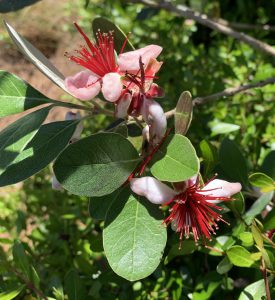
Edible, pollinator-friendly Pineapple Guava flowers in bloom. Photo credit: Larry Williams
If you’ve been looking for a quick-growing, low-maintenance screen or a specimen plant for a large landscape bed, you could do a lot worse than the Florida-Friendly Pineapple Guava! As always, if you have any questions about Pineapple Guava or any other horticulture, agriculture or natural resource related issue, contact your local UF/IFAS County Extension Office!


















